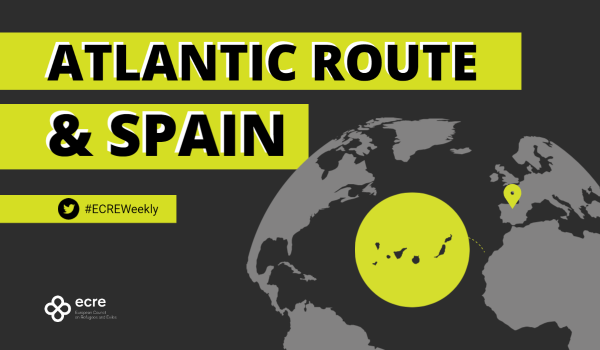A sharp rise of irregular crossings has been noted on the Atlantic Route towards the Canaries amid ongoing deaths and distress calls. Spain sends surveillance drones to Senegal and deploys security personnel along the Senegalese-Mauritanian borders.
The Western African Route, connecting Western African countries and regions to the Canary Islands, has seen a sharp rise in irregular crossings, which nearly doubled so far this year to over 27.700 mainly from Morrocco, Guinea and Senegal, according to the European Border Agency, Frontex. The total number represents 95% of increase compared to the same period between January and October last year. Meanwhile, the Spanish authorities said that a total of 30,705 undocumented migrants had reached the Canary Islands in the first 10 months of this year, representing a 111% increase from the same period in 2022, adding that it would create additional emergency accommodation for some 3,000 migrants in military barracks, hotels and hostels. On 17 November, Alarm Phone reported that almost 1000 people tried crossing the land border between Morocco and the Spanish city of Ceuta located on the north coast of Africa. “Many ended up in hospital. We condemn the violence from both the Guardia Civil and the Moroccan Auxiliary Forces”, the hotline added.
Deaths and distress calls continue. On 30 October, the bodies of two people were found on a boat carrying more than 200 migrants that was located off the Canary Island of Tenerife. According to the Spanish authorities, the boat carrying the lifeless bodies was the third one arriving at the island after two other boats carrying a total of 178 people. On 2 November, InfoMigrants reported that it received an inquiry regarding the fate of another boat that had set out from Kartong, a coastal village bordering Senegal, in mid-October with around 50 to 60 people on board. “Since their departure no one has heard from them. They were heading to Spain…. Everyone here is worried”. On 4 November, more than 500 migrants were rescued in the waters off El Hierro, one of the smallest Canary Islands, from four separate boats. Two lifeless bodies were onboard one of the boats and two additional people died later in the hospital. On 14 November, more than 15 bodies of migrants attempting to reach the Spanish Canary Islands were found on Mauritania’s northern coast as a result of a shipwreck. This tragic news came a week after another 13 bodies were found in the same area. On 17 November, at least seven people were reported to have drowned in the Atlantic Ocean during a 15-day journey from Gambia to the Canary Islands. On 19 November, Alarm Phone reported about 50 people in distress onboard a boat that left from Tantan towards Lanzarote and called on the Spanish coastguard for immediate rescue. Helena Maleno Garzón from NGO Caminando Fronteras reported on 21 November about 25 people in distress including eight women and a three-year-old child who left from Algiers towards Spain, adding that five additional boats in the same area have been reported missing. “The sum would be +90 Missing Persons in the last 10 days”, Garzón said. On 22 November, Garzón reported on an inflatable boat sinking south of Fuerteventura with seventy-three people on board, including fifteen women and three children. On the same day, Alarm Phone reported about two missing boats carrying 17 people that left from Mostaganem and Boumerdes in Algeria fearing “another tragedy” and demanding “the end of the deadly border regime”. On 23 November, Salvamento Marítimo rescued a group of 87 migrants including a woman in labour and several babies that left from Dakhla in Western Sahara following a distress call from Alarm Phone. Journalist Txema Santana wrote on the same day: “Between yesterday and early today they have rescued more than 200 people on three different islands. In recent days, more Gambian canoes have been seen, some boats (they had not been seen for a long time) and a slight reactivation of departures from Western Sahara (medium route) (translated). The journalist wrote on X on 24 November that “An excursion boat for tourists was sailing south of Tenerife with the idea of spotting dolphins when 68 survivors who had been at sea for 7 days were found in the landscape”.
Spain sent six new surveillance drones to Senegal, a main country of origin of migrants arriving on Spain’s Canary Islands, in an attempt to stop the boats departing from the West African country. Spain’s acting Interior Minister, Fernando Grande-Marlaska said during a joint press conference with his Senegalese counterpart, Sidiki Kaba: “We must stop unscrupulous actions that put the lives of thousands of vulnerable people at risk,” referring to the Spanish drones designed to detect the departing boats to be intercepted. The Spanish interior minister additionally declared that his country deployed a civil guard aircraft to help patrol the coasts of Senegal and neighboring Mauritania. 38 personnel equipped with four boats, a helicopter and 13 all-terrain vehicles will carry out joint patrol missions with Senegalese forces, Grande-Marlaska said. Grande-Marlaska also plans to speed up the return of migrants who have arrived in the Canaries in the last three months and are considered by the authorities not to have valid grounds to claim asylum.
For more information:
- ECRE, Atlantic Route and Spain: Government Expects to Deliver on Pact Despite Parliament Elections, Melilla Victims Still Waiting for Justice, Lack of Rescue Coordination with Morocco Continues to Cost Lives, June 2023
- ECRE, Atlantic Route and Spain: PM Hails Morocco as Essential Partner Amid Critique of Too Many Concessions, Significant Decrease of Arrivals to Canary Islands – Deaths and Distress at Sea Continue, May 2023

